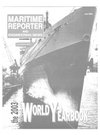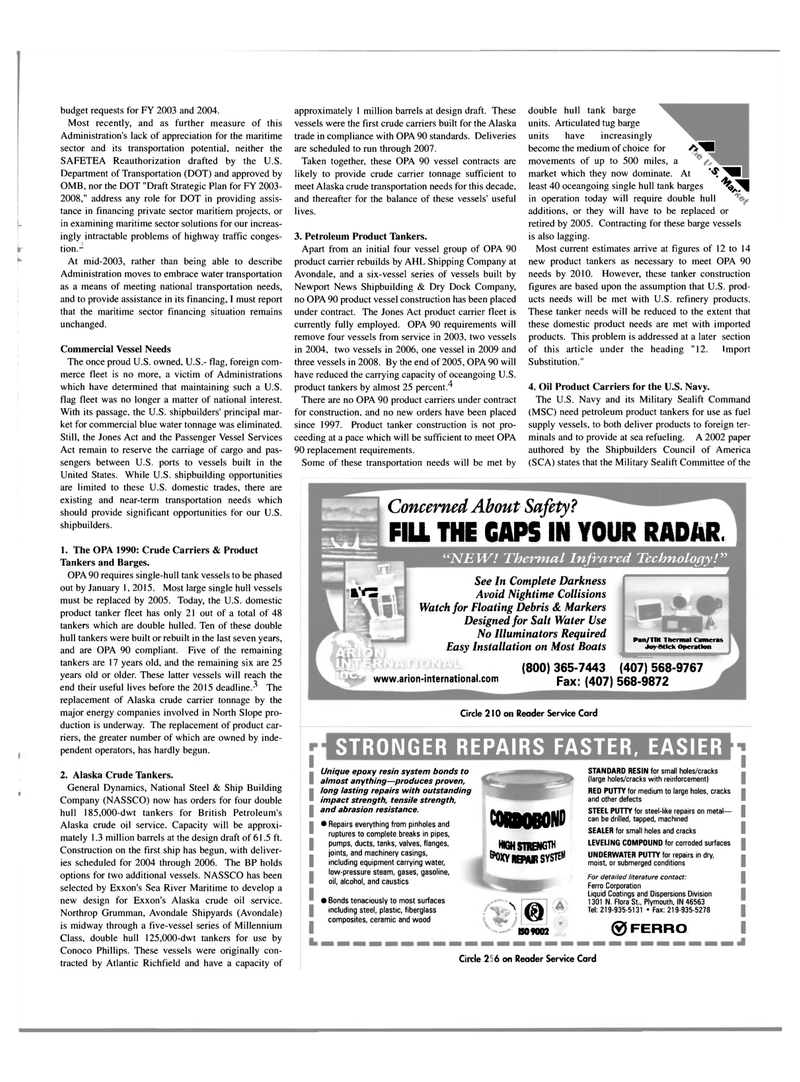
Page 51: of Maritime Reporter Magazine (June 2003)
Read this page in Pdf, Flash or Html5 edition of June 2003 Maritime Reporter Magazine
budget requests for FY 2003 and 2004.
Most recently, and as further measure of this
Administration's lack of appreciation for the maritime sector and its transportation potential, neither the
SAFETEA Reauthorization drafted by the U.S.
Department of Transportation (DOT) and approved by
OMB, nor the DOT "Draft Strategic Plan for FY 2003- 2008," address any role for DOT in providing assis- tance in financing private sector maritiem projects, or in examining maritime sector solutions for our increas- ingly intractable problems of highway traffic conges- tion.-
At mid-2003, rather than being able to describe
Administration moves to embrace water transportation as a means of meeting national transportation needs, and to provide assistance in its financing, I must report that the maritime sector financing situation remains unchanged.
Commercial Vessel Needs
The once proud U.S. owned, U.S.- Hag, foreign com- merce fleet is no more, a victim of Administrations which have determined that maintaining such a U.S. flag fleet was no longer a matter of national interest.
With its passage, the U.S. shipbuilders' principal mar- ket for commercial blue water tonnage was eliminated.
Still, the Jones Act and the Passenger Vessel Services
Act remain to reserve the carriage of cargo and pas- sengers between U.S. ports to vessels built in the
United States. While U.S. shipbuilding opportunities are limited to these U.S. domestic trades, there are existing and near-term transportation needs which should provide significant opportunities for our U.S. shipbuilders. 1. The OPA 1990: Crude Carriers & Product
Tankers and Barges.
OPA 90 requires single-hull tank vessels to be phased out by January 1, 2015. Most large single hull vessels must be replaced by 2005. Today, the U.S. domestic product tanker fleet has only 21 out of a total of 48 tankers which are double hulled. Ten of these double hull tankers were built or rebuilt in the last seven years, and are OPA 90 compliant. Five of the remaining tankers are 17 years old, and the remaining six are 25 years old or older. These latter vessels will reach the end their useful lives before the 2015 deadline.-^ The replacement of Alaska crude carrier tonnage by the major energy companies involved in North Slope pro- duction is underway. The replacement of product car- riers, the greater number of which are owned by inde- pendent operators, has hardly begun. 2. Alaska Crude Tankers.
General Dynamics, National Steel & Ship Building
Company (NASSCO) now has orders for four double hull 185,000-dwt tankers for British Petroleum's
Alaska crude oil service. Capacity will be approxi- mately 1.3 million barrels at the design draft of 61.5 ft.
Construction on the first ship has begun, with deliver- ies scheduled for 2004 through 2006. The BP holds options for two additional vessels. NASSCO has been selected by Exxon's Sea River Maritime to develop a new design for Exxon's Alaska crude oil service.
Northrop Grumman, Avondale Shipyards (Avondale) is midway through a five-vessel series of Millennium
Class, double hull 125,000-dwt tankers for use by
Conoco Phillips. These vessels were originally con- tracted by Atlantic Richfield and have a capacity of approximately 1 million barrels at design draft. These vessels were the first crude carriers built for the Alaska trade in compliance with OPA 90 standards. Deliveries are scheduled to run through 2007.
Taken together, these OPA 90 vessel contracts are likely to provide crude carrier tonnage sufficient to meet Alaska crude transportation needs for this decade, and thereafter for the balance of these vessels' useful lives. 3. Petroleum Product Tankers.
Apart from an initial four vessel group of OPA 90 product carrier rebuilds by AHL Shipping Company at
Avondale, and a six-vessel series of vessels built by
Newport News Shipbuilding & Dry Dock Company, no OPA 90 product vessel construction has been placed under contract. The Jones Act product carrier fleet is currently fully employed. OPA 90 requirements will remove four vessels from service in 2003, two vessels in 2004, two vessels in 2006, one vessel in 2009 and three vessels in 2008. By the end of 2005, OPA 90 will have reduced the carrying capacity of oceangoing U.S. product tankers by almost 25 percent.^
There are no OPA 90 product carriers under contract for construction, and no new orders have been placed since 1997. Product tanker construction is not pro- ceeding at a pace which will be sufficient to meet OPA 90 replacement requirements.
Some of these transportation needs will be met by double hull tank barge units. Articulated tug barge units have increasingly become the medium of choice for A^H movements of up to 500 miles, a market which they now dominate. At ^^H least 40 oceangoing single hull tank barges ^^^ in operation today will require double hull additions, or they will have to be replaced or retired by 2005. Contracting for these barge vessels is also lagging.
Most current estimates arrive at figures of 12 to 14 new product tankers as necessary to meet OPA 90 needs by 2010. However, these tanker construction figures are based upon the assumption that U.S. prod- ucts needs will be met with U.S. refinery products.
These tanker needs will be reduced to the extent that these domestic product needs are met with imported products. This problem is addressed at a later section of this article under the heading "12. Import
Substitution." 4. Oil Product Carriers for the U.S. Navy.
The U.S. Navy and its Military Sealift Command (MSC) need petroleum product tankers for use as fuel supply vessels, to both deliver products to foreign ter- minals and to provide at sea refueling. A 2002 paper authored by the Shipbuilders Council of America (SCA) states that the Military Sealift Committee of the
Concerned About Safety?
FILL THE CAPS ti. %'fZ 'NEW! Thermal Infrared Technology!"
See In Complete Darkness
Avoid Nightime Collisions
Watch for Floating Debris & Markers
Designed for Salt Water Use
No Illuminators Required
Easy Installation on Most Boats (800) 365-7443 (407) 568-9767 www.arion-international.com pax: (407) 568-9872
Pan/Ttlt Thermal Cameras
Joy-Stick Operation
Circle 210 on Reader Service Card
STRONGER REPAIRS FASTER, EASIER
Unique epoxy resin system bonds to almost anything—produces proven, long tasting repairs with outstanding impact strength, tensile strength, and abrasion resistance. • Repairs everything from pinholes and ruptures to complete breaks in pipes, pumps, ducts, tanks, valves, flanges, joints, and machinery casings, including equipment carrying water, low-pressure steam, gases, gasoline, oil, alcohol, and caustics • Bonds tenaciously to most surfaces including steel, plastic, fiberglass composites, ceramic and wood
CORDOBOND t HIGH STRENGTH
Ef>°XY!tB>A« SYSTEM \ ©
ISO9002
STANDARD RESIN for small holes/cracks (large holes/cracks with reinforcement)
RED PUTTY for medium to large holes, cracks and other defects
STEEL PUTTY for steel-like repairs on metal— can be drilled, tapped, machined
SEALER for small holes and cracks
LEVELING COMPOUND for corroded surfaces
UNDERWATER PUTTY for repairs in dry, moist, or submerged conditions
For detailed literature contact:
Ferro Corporation
Liquid Coatings and Dispersions Division 1301 N. Flora St., Plymouth, IN 46563
Tel: 219-935-5131 • Fax: 219-935-5278 ®FERRO
Circle 286 on Reader Service Card 53

 50
50

 52
52
